Progress Report: Resolution of Scaffolding Issues, MGT726 Project
VerifiedAdded on 2023/06/07
|24
|4534
|439
Report
AI Summary
This progress report details the research conducted to date on the resolution of a scaffolding problem faced by Caledonia, a scaffolding company. The report outlines the management problem, research questions, and objectives, focusing on complaints from local residents and resource utilization. It includes a literature review on scaffolding, licensing, and safety, along with the research methodology, data collection techniques, and proposed data analysis. The report covers various types of scaffolding, licensing requirements, and the impact of scaffolding construction. The report also incorporates tables and figures, including a conceptual model, Gantt chart, and survey details, to provide a comprehensive overview of the research progress. The objective is to find Australian best practices for scaffolding to minimize disruption and meet safety requirements. The report also includes an executive summary, table of contents, list of figures, list of tables, list of abbreviations, introduction, literature review, methodology, proposed analysis of results, references, and appendices.

RESOLUTION OF SCAFFOLDING
PROBLEM.
[Put your full name here]
[student number – i……..]
[date]
[MGT726 Managerial Project]
School of Business
Faculty of Arts and Business
University of the Sunshine Coast
PROBLEM.
[Put your full name here]
[student number – i……..]
[date]
[MGT726 Managerial Project]
School of Business
Faculty of Arts and Business
University of the Sunshine Coast
Paraphrase This Document
Need a fresh take? Get an instant paraphrase of this document with our AI Paraphraser
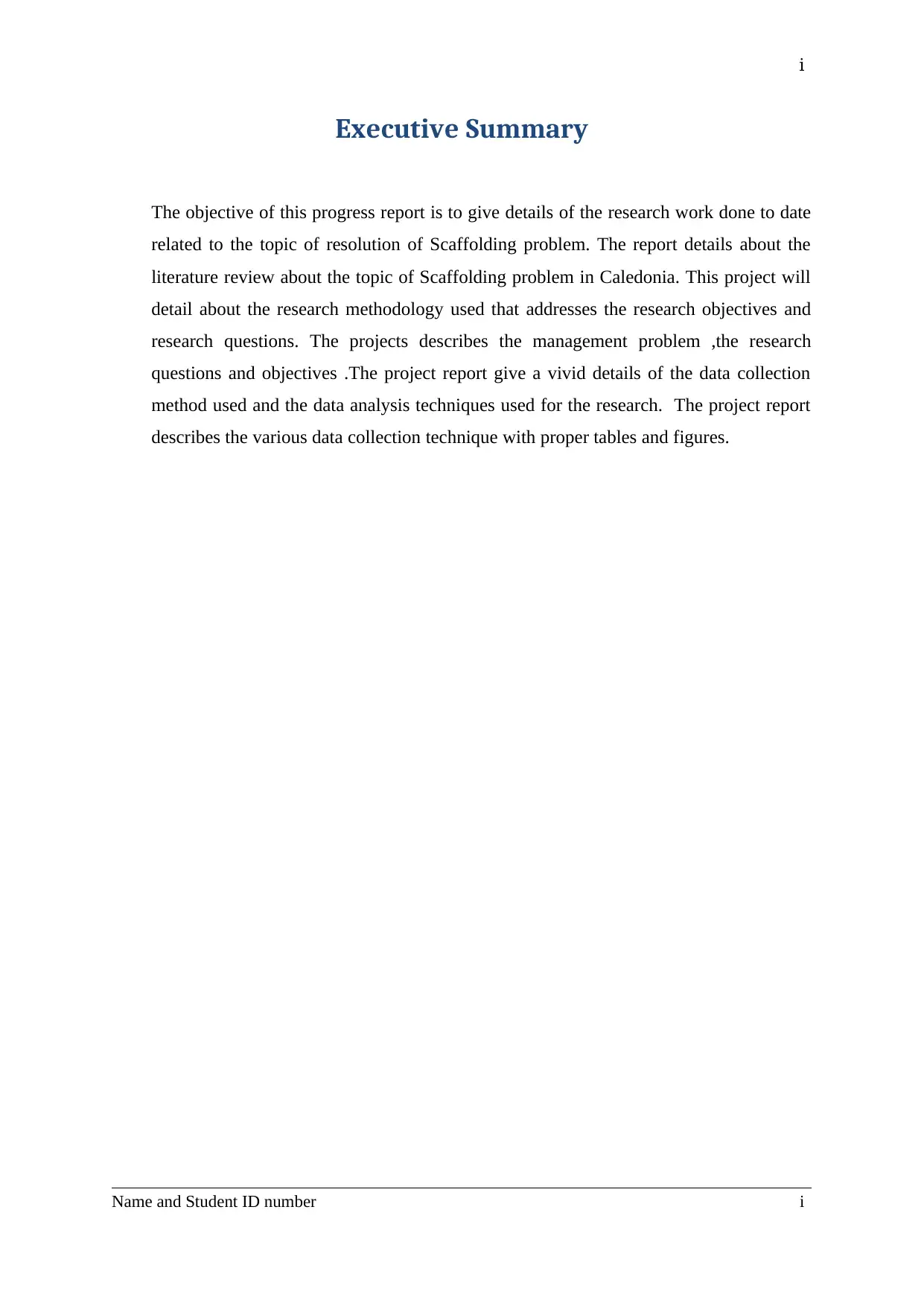
i
Executive Summary
The objective of this progress report is to give details of the research work done to date
related to the topic of resolution of Scaffolding problem. The report details about the
literature review about the topic of Scaffolding problem in Caledonia. This project will
detail about the research methodology used that addresses the research objectives and
research questions. The projects describes the management problem ,the research
questions and objectives .The project report give a vivid details of the data collection
method used and the data analysis techniques used for the research. The project report
describes the various data collection technique with proper tables and figures.
Name and Student ID number i
Executive Summary
The objective of this progress report is to give details of the research work done to date
related to the topic of resolution of Scaffolding problem. The report details about the
literature review about the topic of Scaffolding problem in Caledonia. This project will
detail about the research methodology used that addresses the research objectives and
research questions. The projects describes the management problem ,the research
questions and objectives .The project report give a vivid details of the data collection
method used and the data analysis techniques used for the research. The project report
describes the various data collection technique with proper tables and figures.
Name and Student ID number i
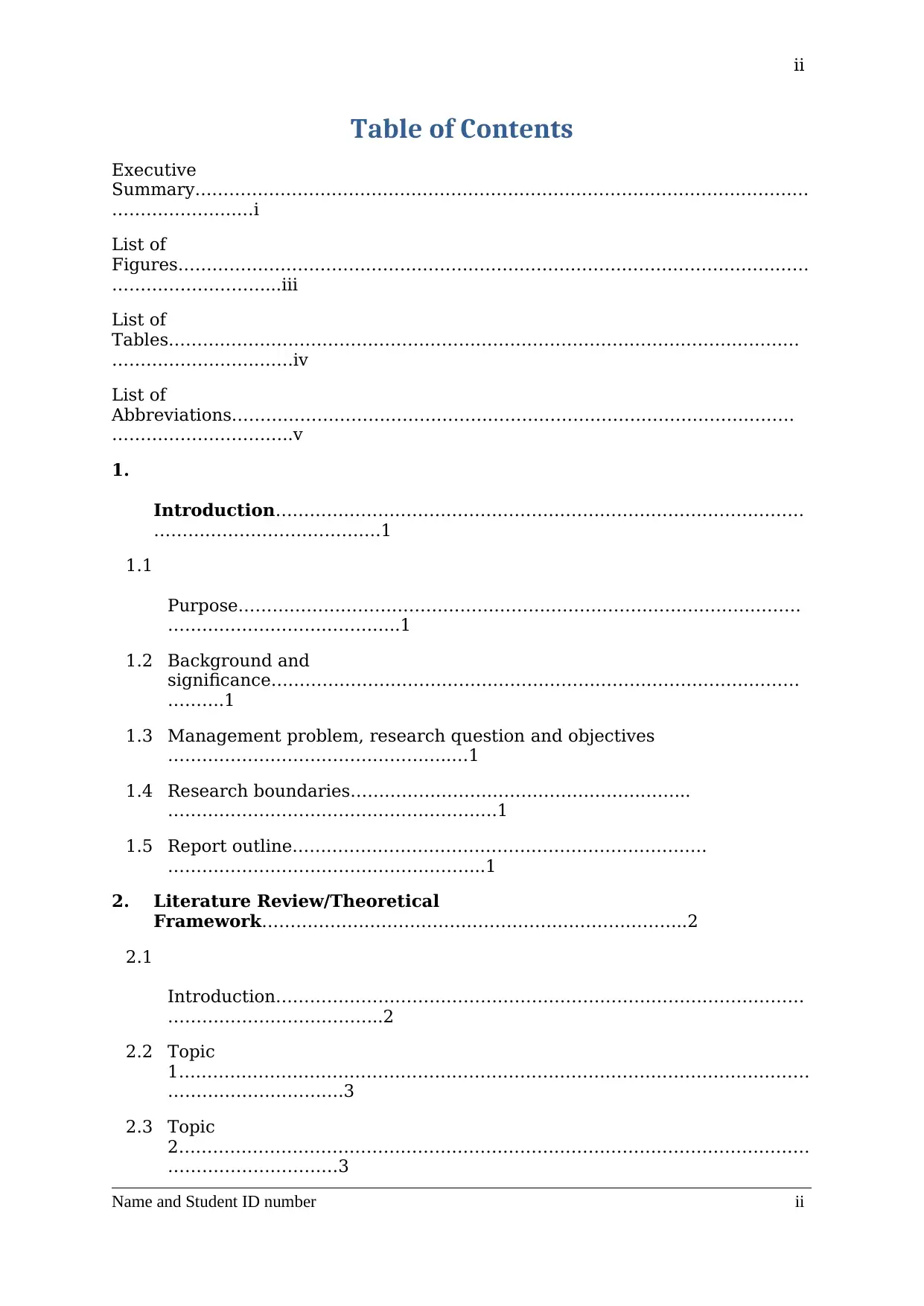
ii
Table of Contents
Executive
Summary………………………………………………………………………………………………
………………….…i
List of
Figures…………………………………………………………………………………………………
………………………...iii
List of
Tables…………………………………………………………………………………………………
…………………….…….iv
List of
Abbreviations………………………………………………………………………………………
…………………………..v
1.
Introduction…………………………………………………………………………………
………………………………….1
1.1
Purpose………………………………………………………………………………………
…………………………………..1
1.2 Background and
significance…………………………………………………………………………………
……….1
1.3 Management problem, research question and objectives
…………………………………………..…1
1.4 Research boundaries…………………………………………………...
………………………………………………….1
1.5 Report outline……………………………………………………………….
………………………………………………..1
2. Literature Review/Theoretical
Framework…………………………………………….…………………..2
2.1
Introduction…………………………………………………………………………………
………………………………..2
2.2 Topic
1…………………………………………………………………………………………………
………………………….3
2.3 Topic
2…………………………………………………………………………………………………
…………………………3
Name and Student ID number ii
Table of Contents
Executive
Summary………………………………………………………………………………………………
………………….…i
List of
Figures…………………………………………………………………………………………………
………………………...iii
List of
Tables…………………………………………………………………………………………………
…………………….…….iv
List of
Abbreviations………………………………………………………………………………………
…………………………..v
1.
Introduction…………………………………………………………………………………
………………………………….1
1.1
Purpose………………………………………………………………………………………
…………………………………..1
1.2 Background and
significance…………………………………………………………………………………
……….1
1.3 Management problem, research question and objectives
…………………………………………..…1
1.4 Research boundaries…………………………………………………...
………………………………………………….1
1.5 Report outline……………………………………………………………….
………………………………………………..1
2. Literature Review/Theoretical
Framework…………………………………………….…………………..2
2.1
Introduction…………………………………………………………………………………
………………………………..2
2.2 Topic
1…………………………………………………………………………………………………
………………………….3
2.3 Topic
2…………………………………………………………………………………………………
…………………………3
Name and Student ID number ii
⊘ This is a preview!⊘
Do you want full access?
Subscribe today to unlock all pages.

Trusted by 1+ million students worldwide
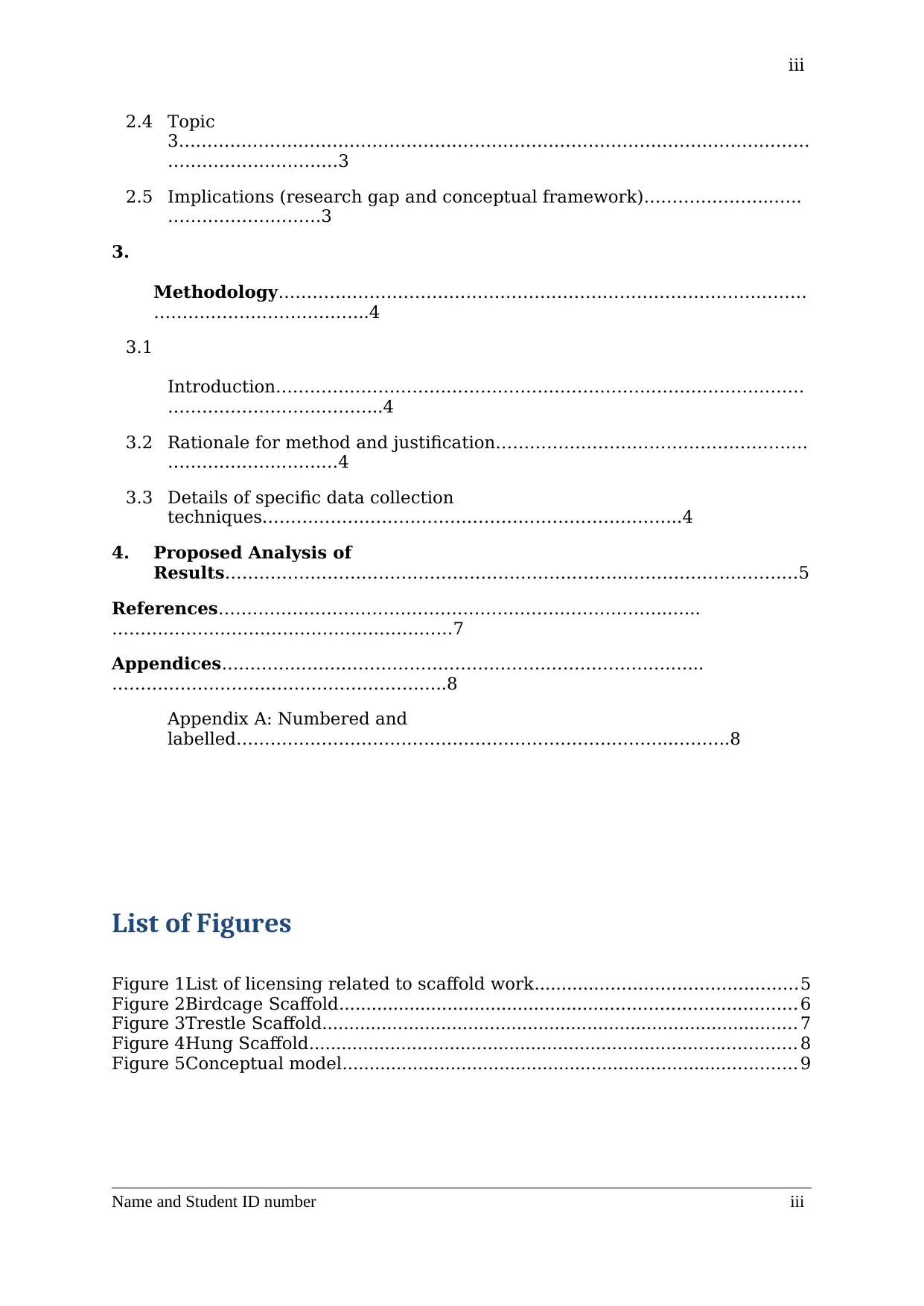
iii
2.4 Topic
3…………………………………………………………………………………………………
…………………………3
2.5 Implications (research gap and conceptual framework)…………………..…..
………………………3
3.
Methodology…………………………………………………………………………………
………………………………..4
3.1
Introduction…………………………………………………………………………………
………………………………..4
3.2 Rationale for method and justification……………………………………………….
…………………………4
3.3 Details of specific data collection
techniques………………………………………………………………..4
4. Proposed Analysis of
Results……………………………………………………………..…………………………5
References…………………………………………………………………….…...
……………………………………………………7
Appendices…………………………………………………………………….…...
…………………………………………………..8
Appendix A: Numbered and
labelled…………………………………………………………………..……….8
List of Figures
Figure 1List of licensing related to scaffold work................................................5
Figure 2Birdcage Scaffold.................................................................................... 6
Figure 3Trestle Scaffold........................................................................................ 7
Figure 4Hung Scaffold.......................................................................................... 8
Figure 5Conceptual model.................................................................................... 9
Name and Student ID number iii
2.4 Topic
3…………………………………………………………………………………………………
…………………………3
2.5 Implications (research gap and conceptual framework)…………………..…..
………………………3
3.
Methodology…………………………………………………………………………………
………………………………..4
3.1
Introduction…………………………………………………………………………………
………………………………..4
3.2 Rationale for method and justification……………………………………………….
…………………………4
3.3 Details of specific data collection
techniques………………………………………………………………..4
4. Proposed Analysis of
Results……………………………………………………………..…………………………5
References…………………………………………………………………….…...
……………………………………………………7
Appendices…………………………………………………………………….…...
…………………………………………………..8
Appendix A: Numbered and
labelled…………………………………………………………………..……….8
List of Figures
Figure 1List of licensing related to scaffold work................................................5
Figure 2Birdcage Scaffold.................................................................................... 6
Figure 3Trestle Scaffold........................................................................................ 7
Figure 4Hung Scaffold.......................................................................................... 8
Figure 5Conceptual model.................................................................................... 9
Name and Student ID number iii
Paraphrase This Document
Need a fresh take? Get an instant paraphrase of this document with our AI Paraphraser
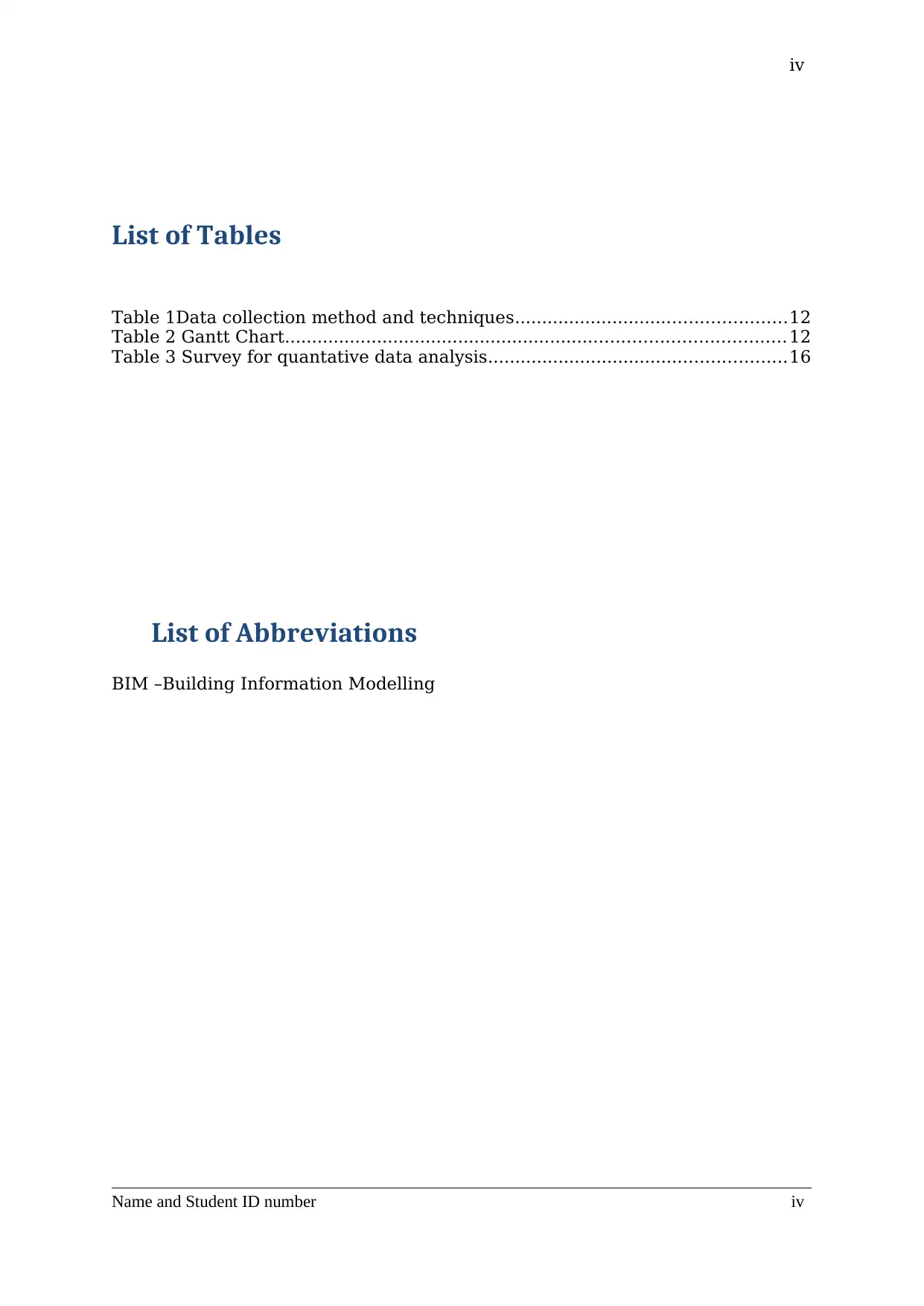
iv
List of Tables
Table 1Data collection method and techniques..................................................12
Table 2 Gantt Chart............................................................................................ 12
Table 3 Survey for quantative data analysis.......................................................16
List of Abbreviations
BIM –Building Information Modelling
Name and Student ID number iv
List of Tables
Table 1Data collection method and techniques..................................................12
Table 2 Gantt Chart............................................................................................ 12
Table 3 Survey for quantative data analysis.......................................................16
List of Abbreviations
BIM –Building Information Modelling
Name and Student ID number iv

v
Name and Student ID number v
Name and Student ID number v
⊘ This is a preview!⊘
Do you want full access?
Subscribe today to unlock all pages.

Trusted by 1+ million students worldwide
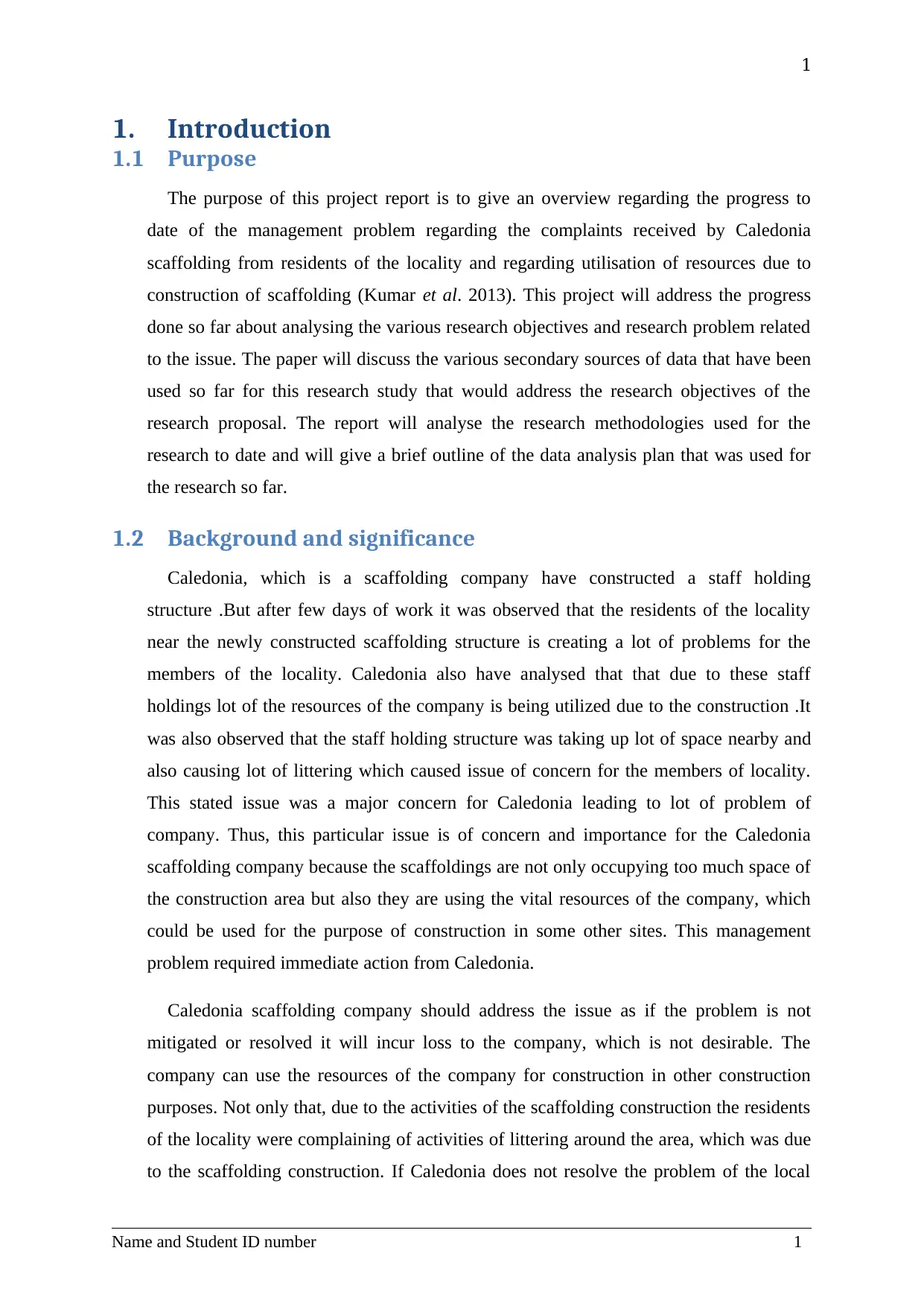
1
1. Introduction
1.1 Purpose
The purpose of this project report is to give an overview regarding the progress to
date of the management problem regarding the complaints received by Caledonia
scaffolding from residents of the locality and regarding utilisation of resources due to
construction of scaffolding (Kumar et al. 2013). This project will address the progress
done so far about analysing the various research objectives and research problem related
to the issue. The paper will discuss the various secondary sources of data that have been
used so far for this research study that would address the research objectives of the
research proposal. The report will analyse the research methodologies used for the
research to date and will give a brief outline of the data analysis plan that was used for
the research so far.
1.2 Background and significance
Caledonia, which is a scaffolding company have constructed a staff holding
structure .But after few days of work it was observed that the residents of the locality
near the newly constructed scaffolding structure is creating a lot of problems for the
members of the locality. Caledonia also have analysed that that due to these staff
holdings lot of the resources of the company is being utilized due to the construction .It
was also observed that the staff holding structure was taking up lot of space nearby and
also causing lot of littering which caused issue of concern for the members of locality.
This stated issue was a major concern for Caledonia leading to lot of problem of
company. Thus, this particular issue is of concern and importance for the Caledonia
scaffolding company because the scaffoldings are not only occupying too much space of
the construction area but also they are using the vital resources of the company, which
could be used for the purpose of construction in some other sites. This management
problem required immediate action from Caledonia.
Caledonia scaffolding company should address the issue as if the problem is not
mitigated or resolved it will incur loss to the company, which is not desirable. The
company can use the resources of the company for construction in other construction
purposes. Not only that, due to the activities of the scaffolding construction the residents
of the locality were complaining of activities of littering around the area, which was due
to the scaffolding construction. If Caledonia does not resolve the problem of the local
Name and Student ID number 1
1. Introduction
1.1 Purpose
The purpose of this project report is to give an overview regarding the progress to
date of the management problem regarding the complaints received by Caledonia
scaffolding from residents of the locality and regarding utilisation of resources due to
construction of scaffolding (Kumar et al. 2013). This project will address the progress
done so far about analysing the various research objectives and research problem related
to the issue. The paper will discuss the various secondary sources of data that have been
used so far for this research study that would address the research objectives of the
research proposal. The report will analyse the research methodologies used for the
research to date and will give a brief outline of the data analysis plan that was used for
the research so far.
1.2 Background and significance
Caledonia, which is a scaffolding company have constructed a staff holding
structure .But after few days of work it was observed that the residents of the locality
near the newly constructed scaffolding structure is creating a lot of problems for the
members of the locality. Caledonia also have analysed that that due to these staff
holdings lot of the resources of the company is being utilized due to the construction .It
was also observed that the staff holding structure was taking up lot of space nearby and
also causing lot of littering which caused issue of concern for the members of locality.
This stated issue was a major concern for Caledonia leading to lot of problem of
company. Thus, this particular issue is of concern and importance for the Caledonia
scaffolding company because the scaffoldings are not only occupying too much space of
the construction area but also they are using the vital resources of the company, which
could be used for the purpose of construction in some other sites. This management
problem required immediate action from Caledonia.
Caledonia scaffolding company should address the issue as if the problem is not
mitigated or resolved it will incur loss to the company, which is not desirable. The
company can use the resources of the company for construction in other construction
purposes. Not only that, due to the activities of the scaffolding construction the residents
of the locality were complaining of activities of littering around the area, which was due
to the scaffolding construction. If Caledonia does not resolve the problem of the local
Name and Student ID number 1
Paraphrase This Document
Need a fresh take? Get an instant paraphrase of this document with our AI Paraphraser
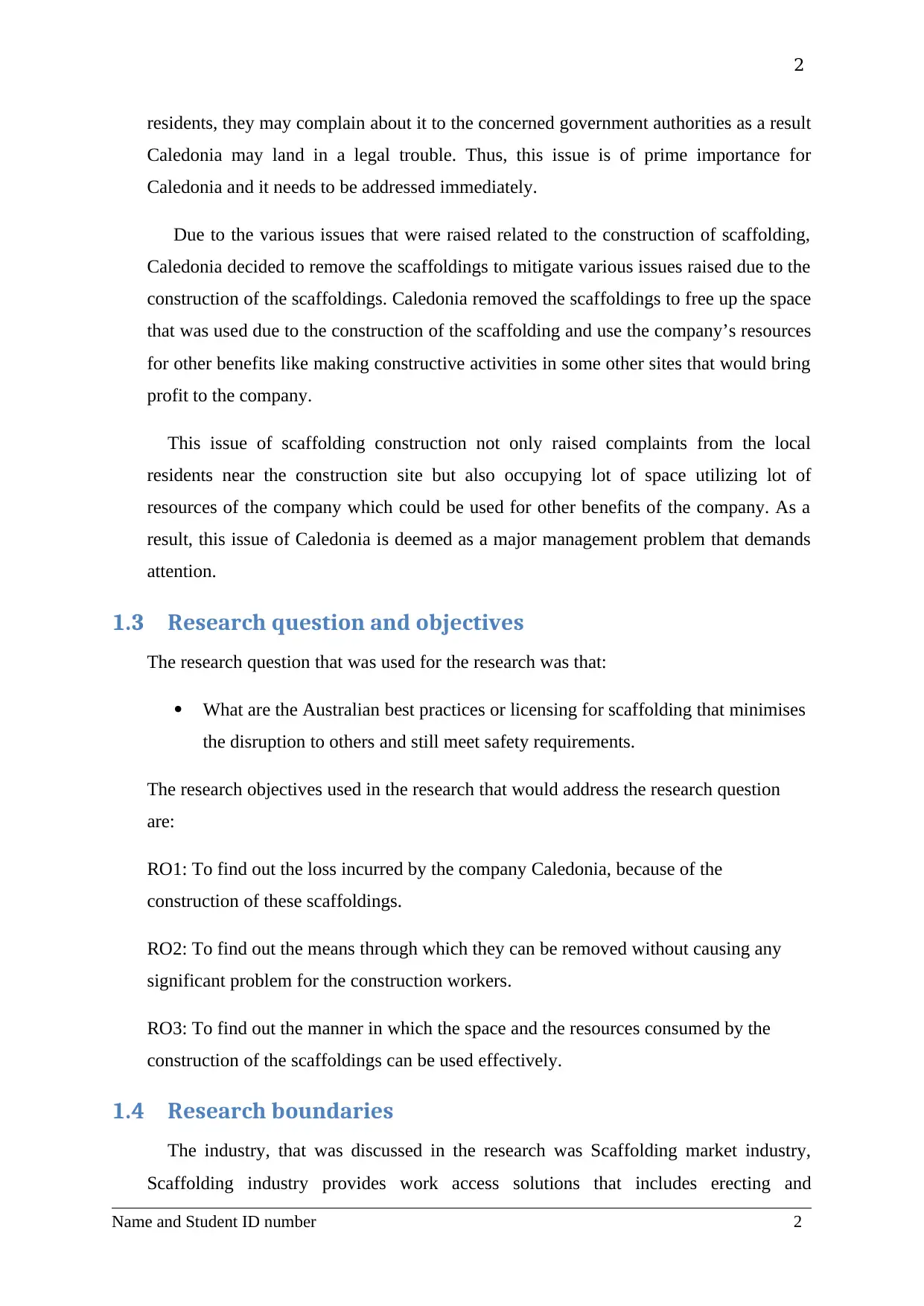
2
residents, they may complain about it to the concerned government authorities as a result
Caledonia may land in a legal trouble. Thus, this issue is of prime importance for
Caledonia and it needs to be addressed immediately.
Due to the various issues that were raised related to the construction of scaffolding,
Caledonia decided to remove the scaffoldings to mitigate various issues raised due to the
construction of the scaffoldings. Caledonia removed the scaffoldings to free up the space
that was used due to the construction of the scaffolding and use the company’s resources
for other benefits like making constructive activities in some other sites that would bring
profit to the company.
This issue of scaffolding construction not only raised complaints from the local
residents near the construction site but also occupying lot of space utilizing lot of
resources of the company which could be used for other benefits of the company. As a
result, this issue of Caledonia is deemed as a major management problem that demands
attention.
1.3 Research question and objectives
The research question that was used for the research was that:
What are the Australian best practices or licensing for scaffolding that minimises
the disruption to others and still meet safety requirements.
The research objectives used in the research that would address the research question
are:
RO1: To find out the loss incurred by the company Caledonia, because of the
construction of these scaffoldings.
RO2: To find out the means through which they can be removed without causing any
significant problem for the construction workers.
RO3: To find out the manner in which the space and the resources consumed by the
construction of the scaffoldings can be used effectively.
1.4 Research boundaries
The industry, that was discussed in the research was Scaffolding market industry,
Scaffolding industry provides work access solutions that includes erecting and
Name and Student ID number 2
residents, they may complain about it to the concerned government authorities as a result
Caledonia may land in a legal trouble. Thus, this issue is of prime importance for
Caledonia and it needs to be addressed immediately.
Due to the various issues that were raised related to the construction of scaffolding,
Caledonia decided to remove the scaffoldings to mitigate various issues raised due to the
construction of the scaffoldings. Caledonia removed the scaffoldings to free up the space
that was used due to the construction of the scaffolding and use the company’s resources
for other benefits like making constructive activities in some other sites that would bring
profit to the company.
This issue of scaffolding construction not only raised complaints from the local
residents near the construction site but also occupying lot of space utilizing lot of
resources of the company which could be used for other benefits of the company. As a
result, this issue of Caledonia is deemed as a major management problem that demands
attention.
1.3 Research question and objectives
The research question that was used for the research was that:
What are the Australian best practices or licensing for scaffolding that minimises
the disruption to others and still meet safety requirements.
The research objectives used in the research that would address the research question
are:
RO1: To find out the loss incurred by the company Caledonia, because of the
construction of these scaffoldings.
RO2: To find out the means through which they can be removed without causing any
significant problem for the construction workers.
RO3: To find out the manner in which the space and the resources consumed by the
construction of the scaffoldings can be used effectively.
1.4 Research boundaries
The industry, that was discussed in the research was Scaffolding market industry,
Scaffolding industry provides work access solutions that includes erecting and
Name and Student ID number 2
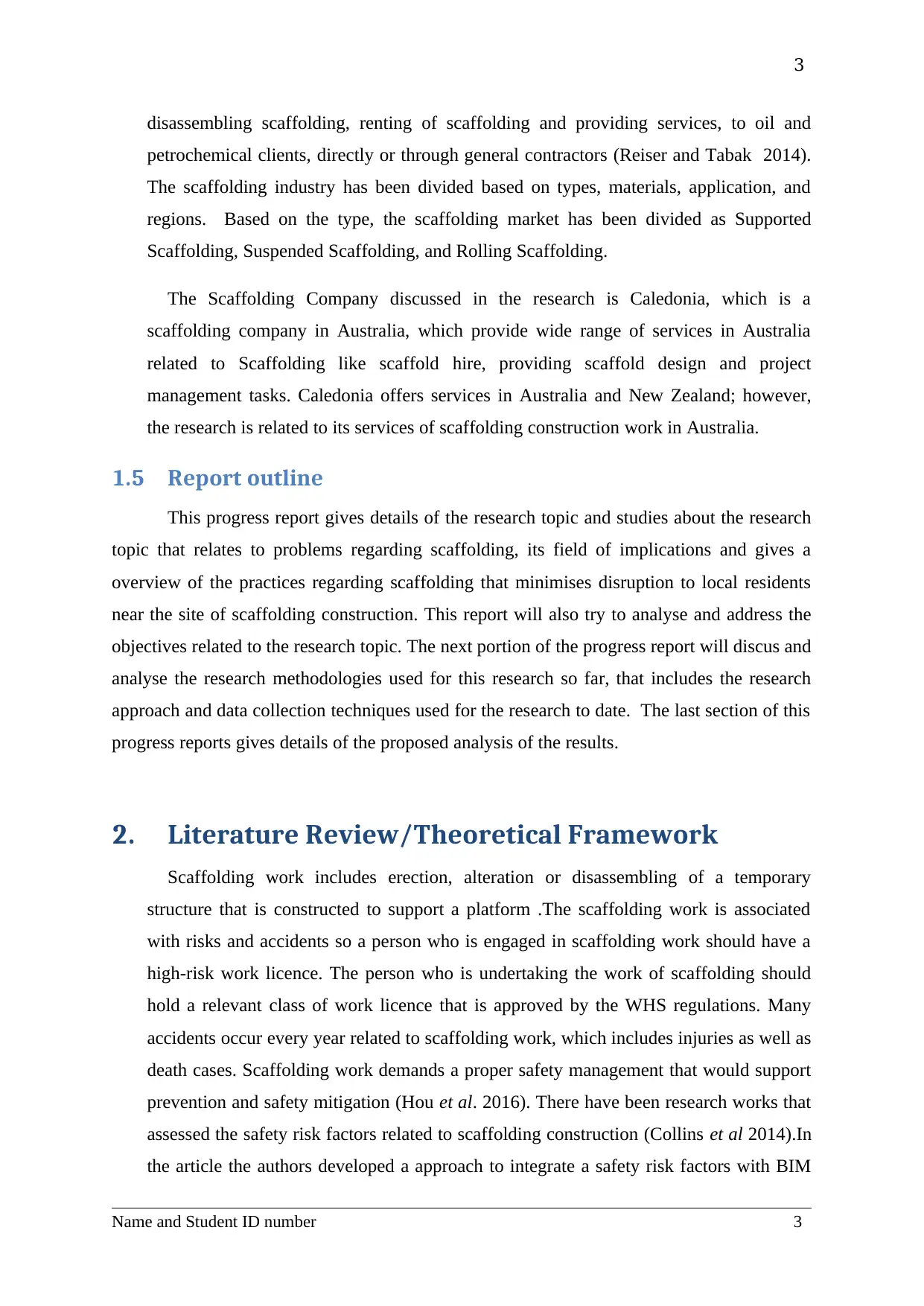
3
disassembling scaffolding, renting of scaffolding and providing services, to oil and
petrochemical clients, directly or through general contractors (Reiser and Tabak 2014).
The scaffolding industry has been divided based on types, materials, application, and
regions. Based on the type, the scaffolding market has been divided as Supported
Scaffolding, Suspended Scaffolding, and Rolling Scaffolding.
The Scaffolding Company discussed in the research is Caledonia, which is a
scaffolding company in Australia, which provide wide range of services in Australia
related to Scaffolding like scaffold hire, providing scaffold design and project
management tasks. Caledonia offers services in Australia and New Zealand; however,
the research is related to its services of scaffolding construction work in Australia.
1.5 Report outline
This progress report gives details of the research topic and studies about the research
topic that relates to problems regarding scaffolding, its field of implications and gives a
overview of the practices regarding scaffolding that minimises disruption to local residents
near the site of scaffolding construction. This report will also try to analyse and address the
objectives related to the research topic. The next portion of the progress report will discus and
analyse the research methodologies used for this research so far, that includes the research
approach and data collection techniques used for the research to date. The last section of this
progress reports gives details of the proposed analysis of the results.
2. Literature Review/Theoretical Framework
Scaffolding work includes erection, alteration or disassembling of a temporary
structure that is constructed to support a platform .The scaffolding work is associated
with risks and accidents so a person who is engaged in scaffolding work should have a
high-risk work licence. The person who is undertaking the work of scaffolding should
hold a relevant class of work licence that is approved by the WHS regulations. Many
accidents occur every year related to scaffolding work, which includes injuries as well as
death cases. Scaffolding work demands a proper safety management that would support
prevention and safety mitigation (Hou et al. 2016). There have been research works that
assessed the safety risk factors related to scaffolding construction (Collins et al 2014).In
the article the authors developed a approach to integrate a safety risk factors with BIM
Name and Student ID number 3
disassembling scaffolding, renting of scaffolding and providing services, to oil and
petrochemical clients, directly or through general contractors (Reiser and Tabak 2014).
The scaffolding industry has been divided based on types, materials, application, and
regions. Based on the type, the scaffolding market has been divided as Supported
Scaffolding, Suspended Scaffolding, and Rolling Scaffolding.
The Scaffolding Company discussed in the research is Caledonia, which is a
scaffolding company in Australia, which provide wide range of services in Australia
related to Scaffolding like scaffold hire, providing scaffold design and project
management tasks. Caledonia offers services in Australia and New Zealand; however,
the research is related to its services of scaffolding construction work in Australia.
1.5 Report outline
This progress report gives details of the research topic and studies about the research
topic that relates to problems regarding scaffolding, its field of implications and gives a
overview of the practices regarding scaffolding that minimises disruption to local residents
near the site of scaffolding construction. This report will also try to analyse and address the
objectives related to the research topic. The next portion of the progress report will discus and
analyse the research methodologies used for this research so far, that includes the research
approach and data collection techniques used for the research to date. The last section of this
progress reports gives details of the proposed analysis of the results.
2. Literature Review/Theoretical Framework
Scaffolding work includes erection, alteration or disassembling of a temporary
structure that is constructed to support a platform .The scaffolding work is associated
with risks and accidents so a person who is engaged in scaffolding work should have a
high-risk work licence. The person who is undertaking the work of scaffolding should
hold a relevant class of work licence that is approved by the WHS regulations. Many
accidents occur every year related to scaffolding work, which includes injuries as well as
death cases. Scaffolding work demands a proper safety management that would support
prevention and safety mitigation (Hou et al. 2016). There have been research works that
assessed the safety risk factors related to scaffolding construction (Collins et al 2014).In
the article the authors developed a approach to integrate a safety risk factors with BIM
Name and Student ID number 3
⊘ This is a preview!⊘
Do you want full access?
Subscribe today to unlock all pages.

Trusted by 1+ million students worldwide
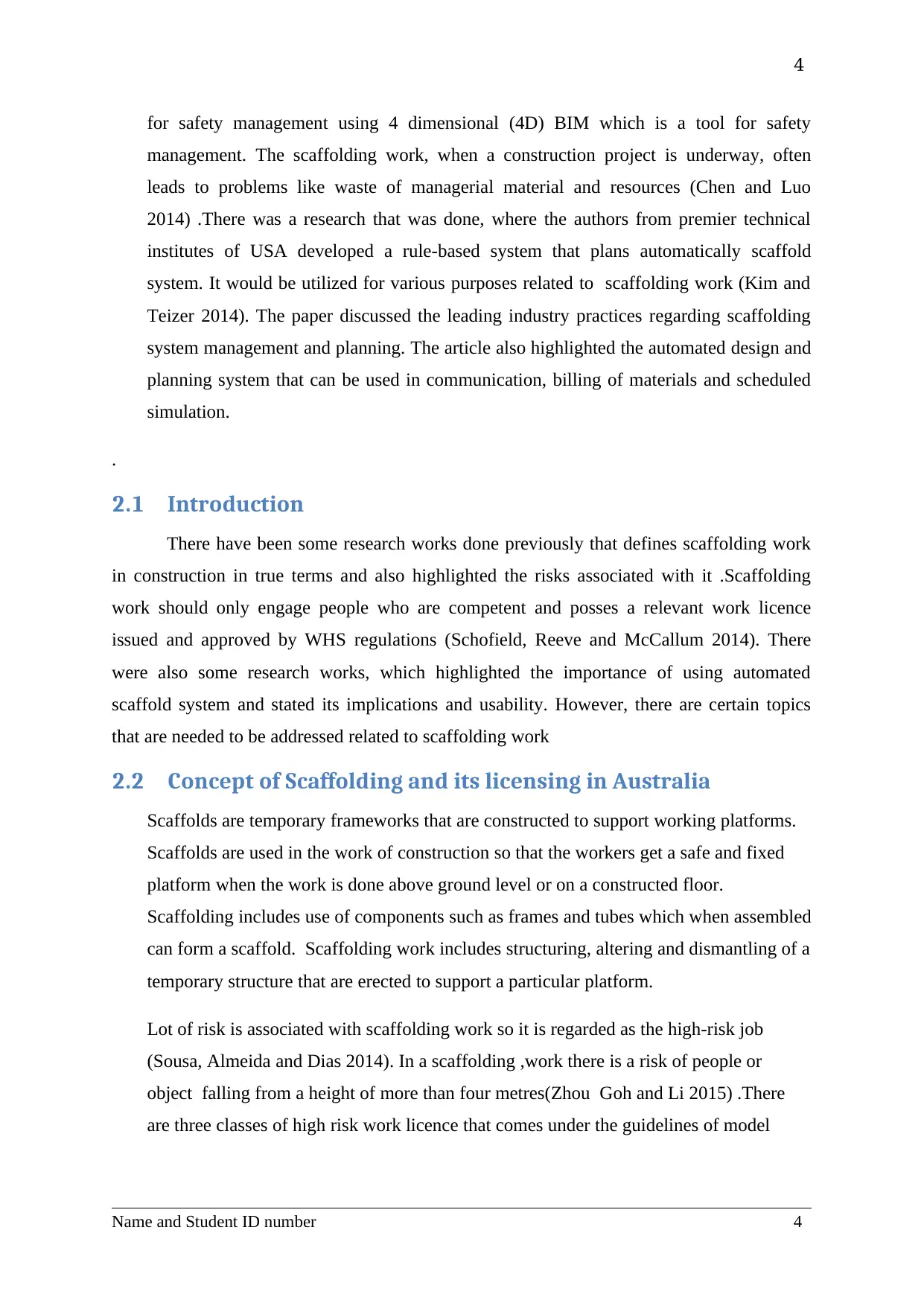
4
for safety management using 4 dimensional (4D) BIM which is a tool for safety
management. The scaffolding work, when a construction project is underway, often
leads to problems like waste of managerial material and resources (Chen and Luo
2014) .There was a research that was done, where the authors from premier technical
institutes of USA developed a rule-based system that plans automatically scaffold
system. It would be utilized for various purposes related to scaffolding work (Kim and
Teizer 2014). The paper discussed the leading industry practices regarding scaffolding
system management and planning. The article also highlighted the automated design and
planning system that can be used in communication, billing of materials and scheduled
simulation.
.
2.1 Introduction
There have been some research works done previously that defines scaffolding work
in construction in true terms and also highlighted the risks associated with it .Scaffolding
work should only engage people who are competent and posses a relevant work licence
issued and approved by WHS regulations (Schofield, Reeve and McCallum 2014). There
were also some research works, which highlighted the importance of using automated
scaffold system and stated its implications and usability. However, there are certain topics
that are needed to be addressed related to scaffolding work
2.2 Concept of Scaffolding and its licensing in Australia
Scaffolds are temporary frameworks that are constructed to support working platforms.
Scaffolds are used in the work of construction so that the workers get a safe and fixed
platform when the work is done above ground level or on a constructed floor.
Scaffolding includes use of components such as frames and tubes which when assembled
can form a scaffold. Scaffolding work includes structuring, altering and dismantling of a
temporary structure that are erected to support a particular platform.
Lot of risk is associated with scaffolding work so it is regarded as the high-risk job
(Sousa, Almeida and Dias 2014). In a scaffolding ,work there is a risk of people or
object falling from a height of more than four metres(Zhou Goh and Li 2015) .There
are three classes of high risk work licence that comes under the guidelines of model
Name and Student ID number 4
for safety management using 4 dimensional (4D) BIM which is a tool for safety
management. The scaffolding work, when a construction project is underway, often
leads to problems like waste of managerial material and resources (Chen and Luo
2014) .There was a research that was done, where the authors from premier technical
institutes of USA developed a rule-based system that plans automatically scaffold
system. It would be utilized for various purposes related to scaffolding work (Kim and
Teizer 2014). The paper discussed the leading industry practices regarding scaffolding
system management and planning. The article also highlighted the automated design and
planning system that can be used in communication, billing of materials and scheduled
simulation.
.
2.1 Introduction
There have been some research works done previously that defines scaffolding work
in construction in true terms and also highlighted the risks associated with it .Scaffolding
work should only engage people who are competent and posses a relevant work licence
issued and approved by WHS regulations (Schofield, Reeve and McCallum 2014). There
were also some research works, which highlighted the importance of using automated
scaffold system and stated its implications and usability. However, there are certain topics
that are needed to be addressed related to scaffolding work
2.2 Concept of Scaffolding and its licensing in Australia
Scaffolds are temporary frameworks that are constructed to support working platforms.
Scaffolds are used in the work of construction so that the workers get a safe and fixed
platform when the work is done above ground level or on a constructed floor.
Scaffolding includes use of components such as frames and tubes which when assembled
can form a scaffold. Scaffolding work includes structuring, altering and dismantling of a
temporary structure that are erected to support a particular platform.
Lot of risk is associated with scaffolding work so it is regarded as the high-risk job
(Sousa, Almeida and Dias 2014). In a scaffolding ,work there is a risk of people or
object falling from a height of more than four metres(Zhou Goh and Li 2015) .There
are three classes of high risk work licence that comes under the guidelines of model
Name and Student ID number 4
Paraphrase This Document
Need a fresh take? Get an instant paraphrase of this document with our AI Paraphraser
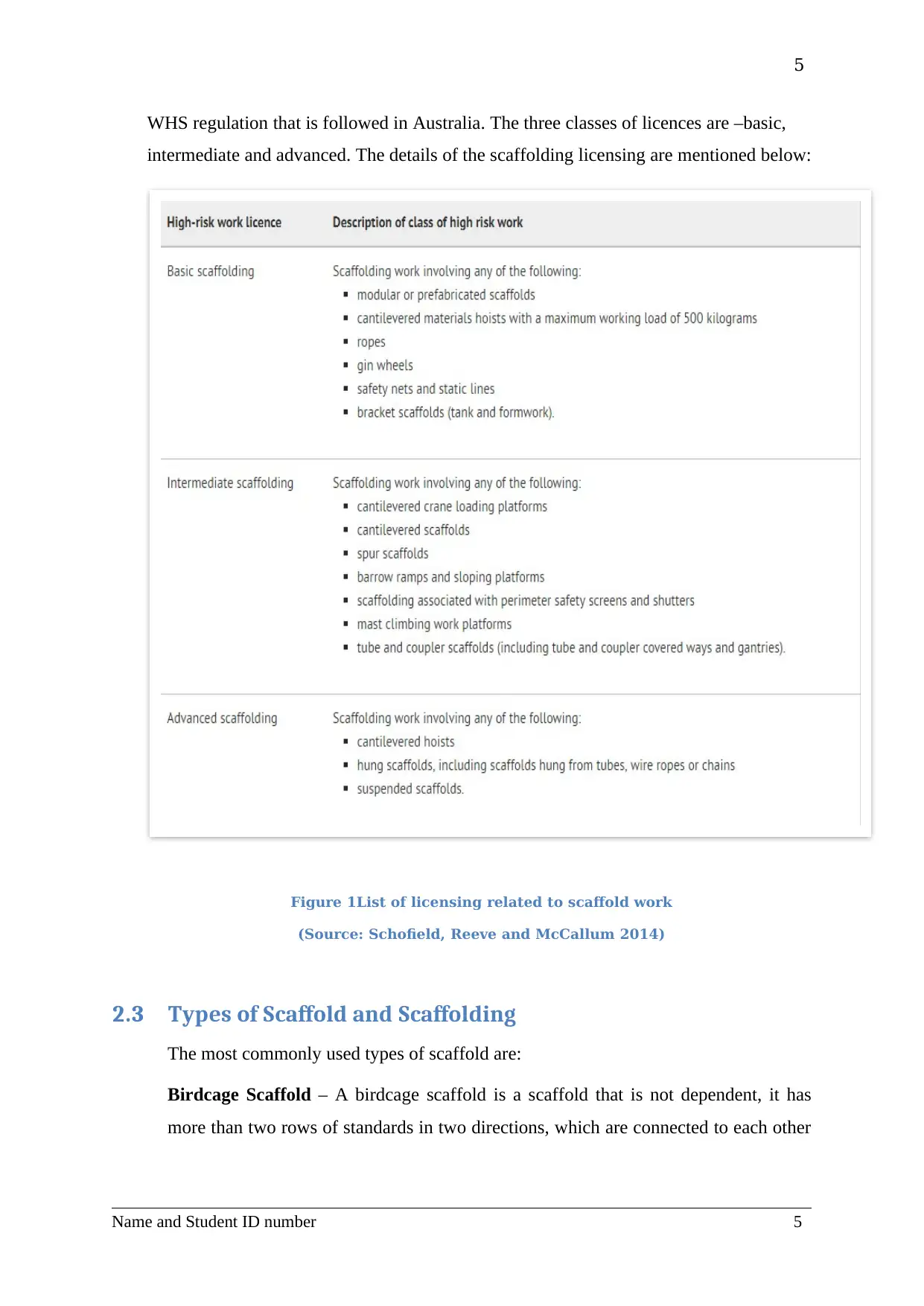
5
WHS regulation that is followed in Australia. The three classes of licences are –basic,
intermediate and advanced. The details of the scaffolding licensing are mentioned below:
Figure 1List of licensing related to scaffold work
(Source: Schofield, Reeve and McCallum 2014)
2.3 Types of Scaffold and Scaffolding
The most commonly used types of scaffold are:
Birdcage Scaffold – A birdcage scaffold is a scaffold that is not dependent, it has
more than two rows of standards in two directions, which are connected to each other
Name and Student ID number 5
WHS regulation that is followed in Australia. The three classes of licences are –basic,
intermediate and advanced. The details of the scaffolding licensing are mentioned below:
Figure 1List of licensing related to scaffold work
(Source: Schofield, Reeve and McCallum 2014)
2.3 Types of Scaffold and Scaffolding
The most commonly used types of scaffold are:
Birdcage Scaffold – A birdcage scaffold is a scaffold that is not dependent, it has
more than two rows of standards in two directions, which are connected to each other
Name and Student ID number 5
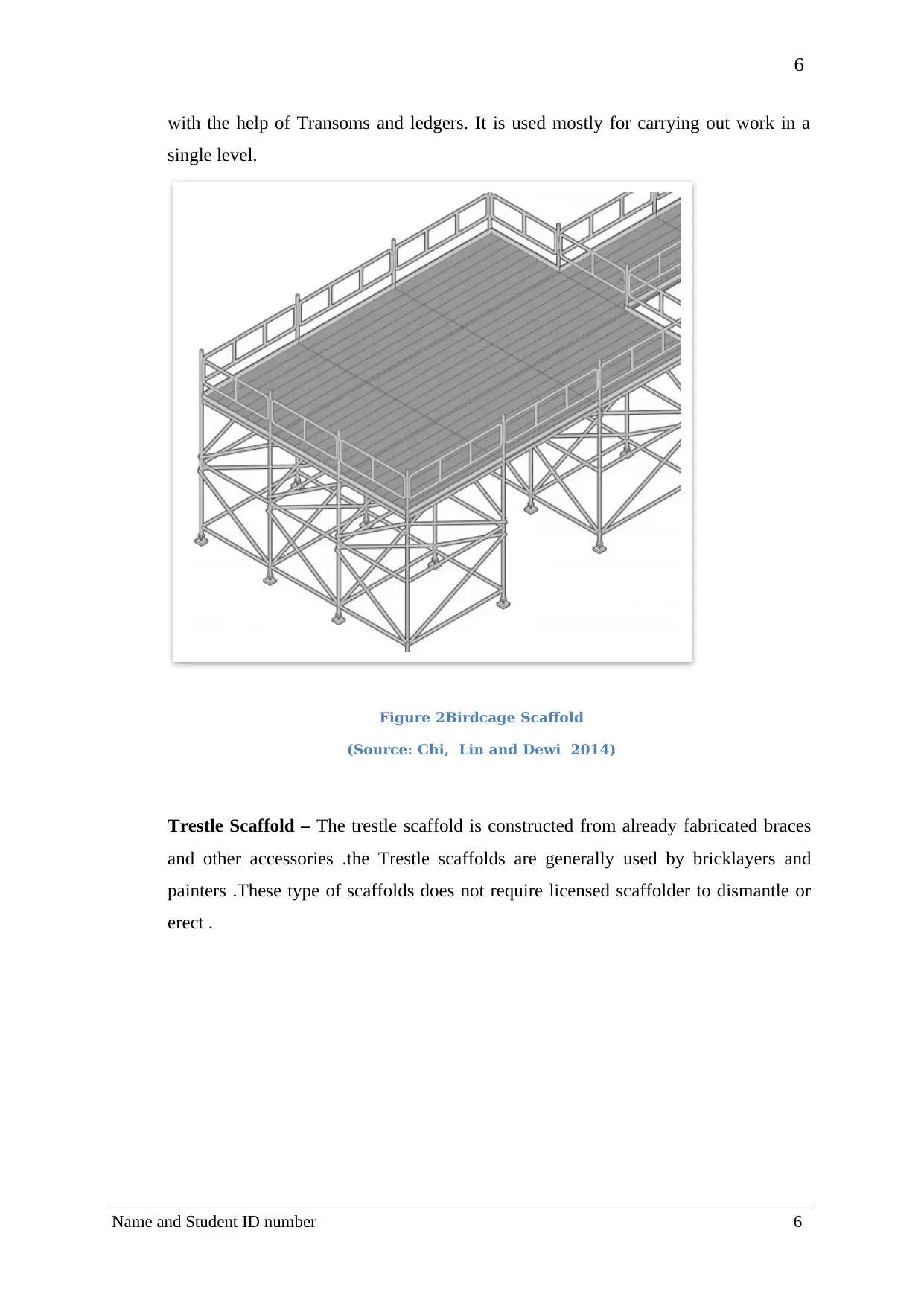
6
with the help of Transoms and ledgers. It is used mostly for carrying out work in a
single level.
Figure 2Birdcage Scaffold
(Source: Chi, Lin and Dewi 2014)
Trestle Scaffold – The trestle scaffold is constructed from already fabricated braces
and other accessories .the Trestle scaffolds are generally used by bricklayers and
painters .These type of scaffolds does not require licensed scaffolder to dismantle or
erect .
Name and Student ID number 6
with the help of Transoms and ledgers. It is used mostly for carrying out work in a
single level.
Figure 2Birdcage Scaffold
(Source: Chi, Lin and Dewi 2014)
Trestle Scaffold – The trestle scaffold is constructed from already fabricated braces
and other accessories .the Trestle scaffolds are generally used by bricklayers and
painters .These type of scaffolds does not require licensed scaffolder to dismantle or
erect .
Name and Student ID number 6
⊘ This is a preview!⊘
Do you want full access?
Subscribe today to unlock all pages.

Trusted by 1+ million students worldwide
1 out of 24
Related Documents
Your All-in-One AI-Powered Toolkit for Academic Success.
+13062052269
info@desklib.com
Available 24*7 on WhatsApp / Email
![[object Object]](/_next/static/media/star-bottom.7253800d.svg)
Unlock your academic potential
Copyright © 2020–2025 A2Z Services. All Rights Reserved. Developed and managed by ZUCOL.





